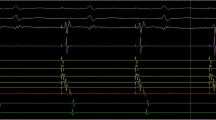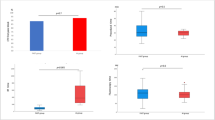Abstract
Introduction
We sought to investigate the use of tissue contact monitoring by means of the electrical coupling index (ECI) in a prospective randomised control trial of patients undergoing cavotricuspid isthmus (CTI) ablation for atrial flutter.
Methods
Patients with ECG-documented typical flutter undergoing their first CTI ablation were randomised to ECI™-guided or non-ECI™-guided ablation. An irrigated-tip ablation catheter was used in all cases. Consecutive 50-W, 60-s radiofrequency lesions were applied to the CTI, from the tricuspid valve to inferior vena cava, with no catheter movement permitted during radiofrequency (RF) delivery. The ablation endpoint was durable CTI block at 20 min post-ablation. Patients underwent routine clinic follow-up post-operatively.
Results
A total of 101 patients (79 male), mean age 66 (+/−11), 50 ECI-guided and 51 control cases were enrolled in the study. CTI block was achieved in all. There were no acute complications. All patients were alive at follow-up. CTI block was achieved in a single pass in 36 ECI-guided and 30 control cases (p = 0.16), and at 20 min post-ablation, re-conduction was seen in 5 and 12 cases, respectively (p = 0.07). There was no significant difference in total procedure time (62.7 ± 33 vs. 62.3 ± 33 min, p = 0.92), RF requirement (580 ± 312 vs. 574 ± 287 s, p = 0.11) or fluoroscopy time (718 ± 577 vs. 721 ± 583 s, p = 0.78). After 6 ± 4 months, recurrence of flutter had occurred in 1 (2 %) ECI vs. 8 (16 %) control cases (OR 0.13, 95 % CI 0.01–1.08, p = 0.06).
Conclusions
ECI-guided CTI ablation demonstrated a non-statistically significant reduction in late recurrence of atrial flutter, at no cost to procedural time, radiation exposure or RF requirement.


Similar content being viewed by others
Abbreviations
- CTI:
-
Cavotricuspid isthmus
- ECI:
-
Electrical coupling index
- RF:
-
Radiofrequency
- AFL:
-
Typical atrial flutter
- AF:
-
Atrial fibrillation
- CF:
-
Contact force
- FTI:
-
Force-time integral
- CS:
-
Coronary sinus
- LVEF:
-
Left ventricular ejection fraction
- LA:
-
Left atrium
- AAD:
-
Anti-arrhythmic drug
- PPM/ICD:
-
Permanent pacemaker/implanted cardiac defibrillator
- EP:
-
Electrophysiology
- HT:
-
Hypertension
- HF:
-
Heart failure
- DM/IGT:
-
Diabetes/impaired glucose tolerance
- CRF:
-
Chronic renal failure
- IHD:
-
Ischemic heart disease
- PVD:
-
Peripheral vascular disease
- CVA/TIA:
-
Cerebrovascular accident/transient ischemic attack
- HCM:
-
Hypertrophic cardiomyopathy
- OSA:
-
Obstructive sleep apnoea
- COPD:
-
Chronic obstructive pulmonary disease
- PV:
-
Pulmonary vein
- PVI:
-
Pulmonary vein isolation
References
Haines, D. (1991). Determinants of lesion size during radiofrequency catheter ablation: the role of electrode-tissue contact pressure and duration of energy delivery. Journal of Cardiovascular Electrophysiology, 2, 509–515.
Avitall, B., Mughal, K., Hare, J., Helms, R., & Krum, D. (1997). The effects of electrode-tissue contact on radiofrequency lesion generation. PACE, 20(Pt. 1), 2899–2910.
Jones, M., Wong, K., Bashir, Y., Betts, T. R., & Rajappan, K. (2013). The determinants of successful RF ablation—is measurement of tissue contact the next step? Recent Patents on Cardiovascular Drug Discovery, 8(2), 151–161. PubMed PMID: 23919428.
Holmes D, Fish J, Byrd I, Dando J, Fowler S, Cao H, Jensen J, Puryear H, Chinitz L: Contact sensing provides a highly accurate means to titrate radiofrequency ablation lesion depth, J Cardiovasc Electrophysiol, 2010; Oct 5th Vol. pp. 1–7)
Piorkowski, C., Sih, H., Sommer, P., Miller, S. P., Gaspar, T., Teplitsky, L., & Hindricks, G. (2009). First in human validation of impedance-based catheter tip-to tissue contact assessment in the left atrium. Journal of Cardiovascular Electrophysiology, 20(12), 1366–1373.
Gaspar, T., Sih, H., Hindricks, G., Eitel, C., Sommer, P., Kircher, S., Rolf, S., Arya, A., Teplitski, L., & Piorkowski, C. (2013). Use of electrical coupling information in AF catheter ablation: a prospective randomized pilot study. Heart Rhythm, 10(2), 176–181.
Spector, P., Reynolds, M., Calkins, H., Sondhi, M., Xu, Y., Martin, A., Williams, C., & Sledge, I. (2009). Meta-analysis of ablation of atrial flutter and supraventricular tachycardia. The American Journal of Cardiology, 104, 671–677.
Pérez, F., Schubert, C., Parvez, B., Pathak, V., Ellenbogen, K., & Wood, M. (2009). Long-term outcomes after catheter ablation of cavo-tricuspid isthmus dependent atrial flutter: a meta-analysis. Circ Arrhythm Electrophysiol, 2,(4) 393–401.
Moreira, W., Timmermans, C., Wellens, H., Mizusawa, Y., Perez, D., Philippens, S., & Rodriguez, L. (2008). Long term outcome of cavotricuspid isthmus cryoablation for the treatment of common atrial flutter in 180 patients: a single center experience. Journal of Interventional Cardiac Electrophysiology, 21(3), 235–240.
Wakili, R., Clauss, S., Schmidt, V., Ulbrich, M., Hahnefeld, A., Schüssler, F., Siebermair, J., Kääb, S., & Estner, H. (2014). Impact of real-time contact force and impedance measurement in pulmonary vein isolation procedures for treatment of atrial fibrillation. Clinical Research in Cardiology, 103, 97–106.
Stabile, G., Solimene, F., Calò, L., Anselmino, M., Castro, A., Pratola, C., Golia, P., Bottoni, N., Grandinetti, G., De Simone, A., De Ponti, R., Dottori, S., & Bertaglia, E. (2014). Catheter–tissue contact force for pulmonary veins isolation: a pilot multicentre study on effect on procedure and fluoroscopy time. Europace, 16, 335–340.
Martinek, M., Lemes, C., Sigmund, E., Derndorfer, M., Aichinger, J., Winter, S., Nesser, H., & Pürerfellner, H. (2012). Clinical impact of an open-irrigated radiofrequency catheter with direct force measurement on atrial fibrillation ablation. PACE, 35, 1312–1318.
Haldar, S., Jarman, J., Panikker, S., Jones, D., Salukhe, T., Gupta, D., Wynn, G., Hussain, W., Markides, V., & Wong, T. (2013). Contact force sensing technology identifies sites of inadequate contact and reduces acute pulmonary vein reconnection: a prospective case control study. International Journal of Cardiology, 168, 1160–1166.
Neuzil, P., Reddy, V., Kautzner, J., Petru, J., Wichterle, D., Shah, D., Lambert, H., Yulzari, A., Wissner, E., & Kuck, K. (2013). Electrical reconnection after pulmonary vein isolation is contingent on contact force during initial treatment results from the EFFICAS I Study. Circulation. Arrhythmia and Electrophysiology, 6, 327–333.
Wissner, E., Petru, J., Metzner, A., Peichel, P., Soranno, M., Lambert, H., Kautzner, J., Neuzil, P., & Kuck, K. (2011). Abstract 17234: The EFFICAS Studies: reducing low force-time integral (FTI) radiofrequency applications improves procedural efficacy during pulmonary vein isolation. Circulation, 124, A17234.
Sohns, C., Karim, R., Harrison, J., Arujuna, A., Linton, N., Sennett, R., Lambert, H., Leo, G., Williams, S., Razavi, R., Wright, M., Schaeffter, T., O'Neill, M., & Rhode, K. (2014). Quantitative magnetic resonance imaging analysis of the relationship between contact force and left atrial scar formation after catheter ablation of atrial fibrillation. Journal of Cardiovascular Electrophysiology, 25, 138–145.
Gaspar, T., Sih, H., Hindricks, G., Eitel, C., Sommer, P., Kircher, S., Rolf, S., Arya, A., Teplitsky, L., & Piorkowski, C. (2013). Use of electrical coupling information in AF catheter ablation: a prospective randomized pilot study. Heart Rhythm, 10, 176–181.
Dello Russo A, Fassini G, Casella M, Bologna F, Al-Nono O, Colombo D, Biagioli V, Santangeli P, Di Biase L, Zucchetti M, Majocchi B, Marino V, Gallinghouse J, Natale A, Tondo C: Simultaneous assessment of contact pressure and local electrical coupling index using robotic navigation. J Interv Card Electrophysiol
Marijon, E., Fazaa, S., Narayanan, K., Guy-Moyat, B., Bouzeman, A., Providencia, R., Treguer, F., Combes, N., Bortone, A., Boveda, S., Combes, S., & Albenque, J. (2014). Real-time contact force sensing for pulmonary vein isolation in the setting of paroxysmal atrial fibrillation: procedural and 1-year results. Journal of Cardiovascular Electrophysiology, 25, 130–137.
Reddy, V., Shah, D., Kautzner, J., Schmidt, B., Saoudi, N., Herrera, C., Jaïs, P., Hindricks, G., Peichl, P., Yulzari, A., Lambert, H., Neuzil, P., Natale, A., & Kuck, K. (2012). The relationship between contact force and clinical outcome during radiofrequency catheter ablation of atrial fibrillation in the TOCCATA study. Heart Rhythm, 9, 1789–1795.
Matía Francés R, Hernández Madrid A, Delgado A, Carrizo L, Pindado C, Moro Serrano C, Zamorano Gómez J: Characterization of the impact of catheter–tissue contact force in lesion formation during cavo-tricuspid isthmus ablation in an experimental swine model. Europace
Winkle, R., Mead, R., Engel, G., Kong, M., & Patrawala, R. (2013). Physician-controlled costs: the choice of equipment used for atrial fibrillation ablation. Journal of Interventional Cardiac Electrophysiology, 36, 157–165.
Acknowledgments
Dr. Jones’s salary is supported by a grant from the Oxford Biomedical Research Centre.
Author contributions
All of the above-listed authors contributed substantially to the design and execution of this study; Dr. Michael Jones designed the trial methodology, collated the data and drafted the paper submitted for publication; Mr. David Webster approached the participants, made enrolments and randomisation assignment, collated the data and populated the database; Dr. Kelvin Wong critically appraised the protocol, assisted with the conception of the study design and statistics and reviewed the paper for publication; Drs. Hayes and Qureshi assisted in study design conception and data collation and critically appraised the paper for publication; Drs. Rajappan and Bashir contributed to the design of the protocol, the statistical analysis and the analysis of the data and Dr Betts contributed to the formulation of the concept, the creation of the research protocol, the statistical methods and sample size estimate, the interpretation of the data and the critical appraisal of the paper submitted for publication.
Conflict of interest
Dr. Jones received funding from St Jude Medical to support his salary. Dr. Betts has received speaker fees and research grants from St Jude Medical. Dr. Rajappan has received speaker fees from St Jude Medical.
Author information
Authors and Affiliations
Corresponding author
Rights and permissions
About this article
Cite this article
Jones, M.A., Webster, D., Wong, K.C. et al. The benefit of tissue contact monitoring with an electrical coupling index during ablation of typical atrial flutter—a prospective randomised control trial. J Interv Card Electrophysiol 41, 237–244 (2014). https://doi.org/10.1007/s10840-014-9943-6
Received:
Accepted:
Published:
Issue Date:
DOI: https://doi.org/10.1007/s10840-014-9943-6




